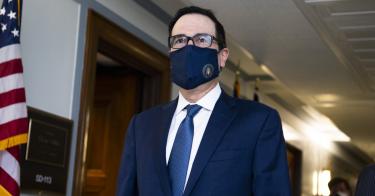My previous column detailed one of the Trump administration’s parting gifts, a harmful last-minute rule proposal that aims to expand anti-money laundering rules. As has been the norm for many years, Treasury proposed an expansion despite the lack of evidence that the existing rules’ benefits outweigh their cost.
This new column covers another holiday disappointment: Treasury’s failure to get Fannie Mae and Freddie Mac out of government conservatorship.
The fact that the GSEs have remained in conservatorship since 2008 is enough of an indictment against Congress and two administrations, but Treasury’s last minute change to the original deal providing the companies with government support is even worse.
Amazingly, after of four years of studying the problem and releasing a reform plan in 2019, the last item in the new agreement announces a “Commitment to Develop [a] Proposal to Resolve Conservatorship.” This so-called commitment would be shameful even if the Trump administration were preparing for its second four-year term.
Just as bad, Treasury’s agreement leaves the folks at the Federal Housing Finance Agency (FHFA) in limbo with respect to last year’s new GSE capital rule.
That FHFA rule is binding only if the GSEs exit conservatorship. But with the new agreement, Treasury essentially states that the GSEs cannot exit conservatorship unless they meet the new common equity requirement. Why, exactly, would Fannie or Freddie try to build that amount of capital now?
The agreement does allow the firms to retain more earnings, which is one way to build capital. And while more capital is generally a positive thing, there are a couple of problems in this case.
First, the precise amount to be retained is somewhat nebulous because capital requirements do not have to be met exclusively with retained earnings. More importantly, the liquidation preference in the conservator agreements increases by any additional net worth if the companies meet the capital requirements.
This addition to the liquidation preference is fine in principle, because the liquidation preference is one of the main protections in place for taxpayers. It is the mechanism that “specifies that any funds derived from either new capital infusions or the liquidation of assets must first be used to compensate taxpayers for the bailout.”
The total amount increased over the years by the additional credit that Treasury provided to the firms, and the combined preference for the two companies is now approximately $230 billion. Therefore, even before the latest amendment, if the companies were to raise, for instance, $200 billion in capital to meet the FHFA’s new capital requirements, they would still need to pay another $230 billion to the Treasury.
The liquidation preference is a major hurdle to raising sufficient capital and exiting government conservatorship. The fact that Treasury included a new mechanism to add to the liquidation preference in this manner is telling.
There is no practical reason that Treasury could not have ended the conservatorship and given the GSEs, for example, 15 years from the date of meeting its capital requirements to pay off the liquidation preference. They even could have added another five years to meet the capital requirements and forced the taxpayers to take a haircut by reducing the total amount owed. (Not that such a move would have been optimal.)
Any similar combination would have put the companies on a path toward building capital while giving markets plenty warning and time to adjust to any changes in their operations. Instead, the liquidation preference is now likely to grow and become an even bigger hurdle to getting the firms out of government conservatorship.
Treasury simply kicked the problem further down the road, possibly to an administration eager to use the sky-high liquidation preference to justify officially making the GSEs part of the federal government.
The Trump administration had more than enough time to develop strict capital rules that held Fannie and Freddie accountable, just as those faced by other large U.S. financial institutions. The FHFA delivered on the basic rules, but Treasury failed horribly on the accountability.
Congress long ago created a housing finance system that benefits special interests and fleeces federal taxpayers. The Trump administration had the chance to implement countless reforms to move away from that system and toward a more competitive market that protected taxpayers and benefited homeowners. They pretty much blew it.
This piece originally appeared in Forbes https://www.forbes.com/sites/norbertmichel/2021/02/01/treasurys-christmas-gift-part-2-another-flawed-gse-decision/?sh=65a8d1c279c5



